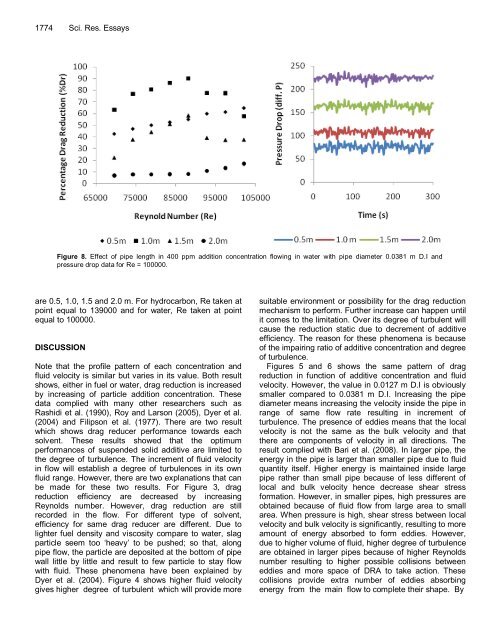Download complete issue (pdf 3360kb) - Academic Journals
Download complete issue (pdf 3360kb) - Academic Journals
Download complete issue (pdf 3360kb) - Academic Journals
Create successful ePaper yourself
Turn your PDF publications into a flip-book with our unique Google optimized e-Paper software.
1774 Sci. Res. Essays<br />
Figure 8. Effect of pipe length in 400 ppm addition concentration flowing in water with pipe diameter 0.0381 m D.I and<br />
pressure drop data for Re = 100000.<br />
are 0.5, 1.0, 1.5 and 2.0 m. For hydrocarbon, Re taken at<br />
point equal to 139000 and for water, Re taken at point<br />
equal to 100000.<br />
DISCUSSION<br />
Note that the profile pattern of each concentration and<br />
fluid velocity is similar but varies in its value. Both result<br />
shows, either in fuel or water, drag reduction is increased<br />
by increasing of particle addition concentration. These<br />
data complied with many other researchers such as<br />
Rashidi et al. (1990), Roy and Larson (2005), Dyer et al.<br />
(2004) and Filipson et al. (1977). There are two result<br />
which shows drag reducer performance towards each<br />
solvent. These results showed that the optimum<br />
performances of suspended solid additive are limited to<br />
the degree of turbulence. The increment of fluid velocity<br />
in flow will establish a degree of turbulences in its own<br />
fluid range. However, there are two explanations that can<br />
be made for these two results. For Figure 3, drag<br />
reduction efficiency are decreased by increasing<br />
Reynolds number. However, drag reduction are still<br />
recorded in the flow. For different type of solvent,<br />
efficiency for same drag reducer are different. Due to<br />
lighter fuel density and viscosity compare to water, slag<br />
particle seem too ‘heavy’ to be pushed; so that, along<br />
pipe flow, the particle are deposited at the bottom of pipe<br />
wall little by little and result to few particle to stay flow<br />
with fluid. These phenomena have been explained by<br />
Dyer et al. (2004). Figure 4 shows higher fluid velocity<br />
gives higher degree of turbulent which will provide more<br />
suitable environment or possibility for the drag reduction<br />
mechanism to perform. Further increase can happen until<br />
it comes to the limitation. Over its degree of turbulent will<br />
cause the reduction static due to decrement of additive<br />
efficiency. The reason for these phenomena is because<br />
of the impairing ratio of additive concentration and degree<br />
of turbulence.<br />
Figures 5 and 6 shows the same pattern of drag<br />
reduction in function of additive concentration and fluid<br />
velocity. However, the value in 0.0127 m D.I is obviously<br />
smaller compared to 0.0381 m D.I. Increasing the pipe<br />
diameter means increasing the velocity inside the pipe in<br />
range of same flow rate resulting in increment of<br />
turbulence. The presence of eddies means that the local<br />
velocity is not the same as the bulk velocity and that<br />
there are components of velocity in all directions. The<br />
result complied with Bari et al. (2008). In larger pipe, the<br />
energy in the pipe is larger than smaller pipe due to fluid<br />
quantity itself. Higher energy is maintained inside large<br />
pipe rather than small pipe because of less different of<br />
local and bulk velocity hence decrease shear stress<br />
formation. However, in smaller pipes, high pressures are<br />
obtained because of fluid flow from large area to small<br />
area. When pressure is high, shear stress between local<br />
velocity and bulk velocity is significantly, resulting to more<br />
amount of energy absorbed to form eddies. However,<br />
due to higher volume of fluid, higher degree of turbulence<br />
are obtained in larger pipes because of higher Reynolds<br />
number resulting to higher possible collisions between<br />
eddies and more space of DRA to take action. These<br />
collisions provide extra number of eddies absorbing<br />
energy from the main flow to <strong>complete</strong> their shape. By

















